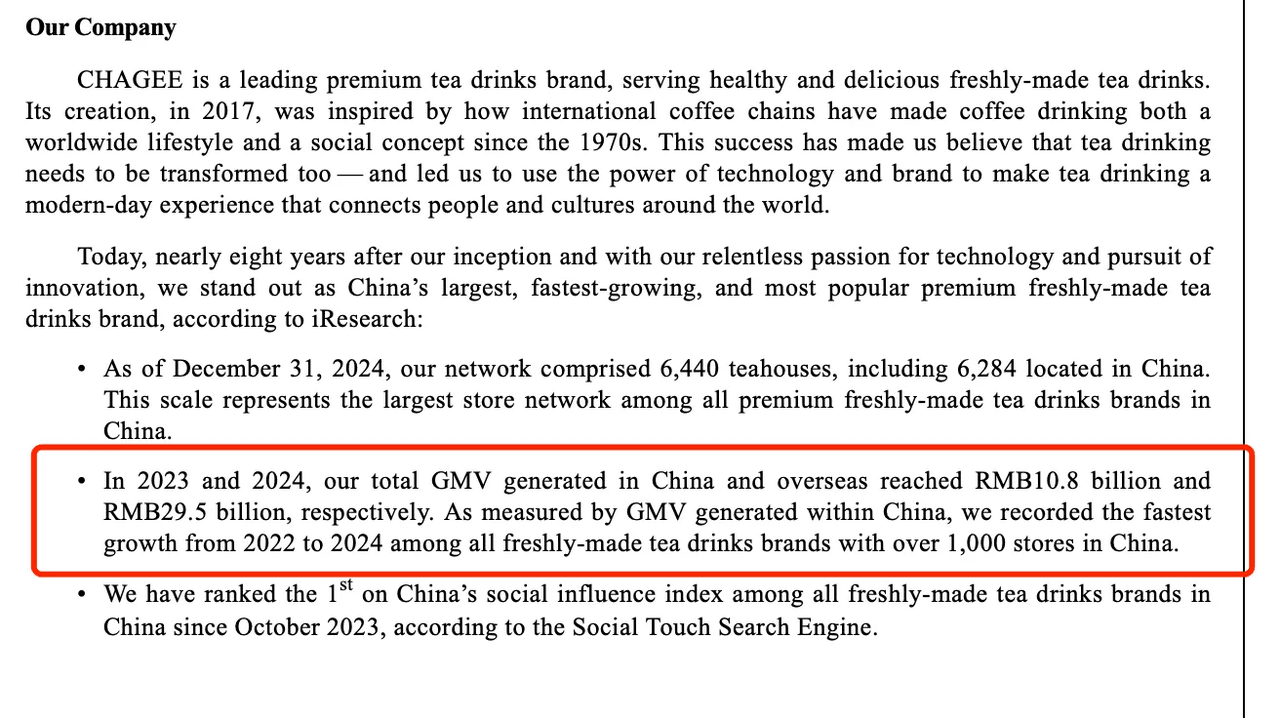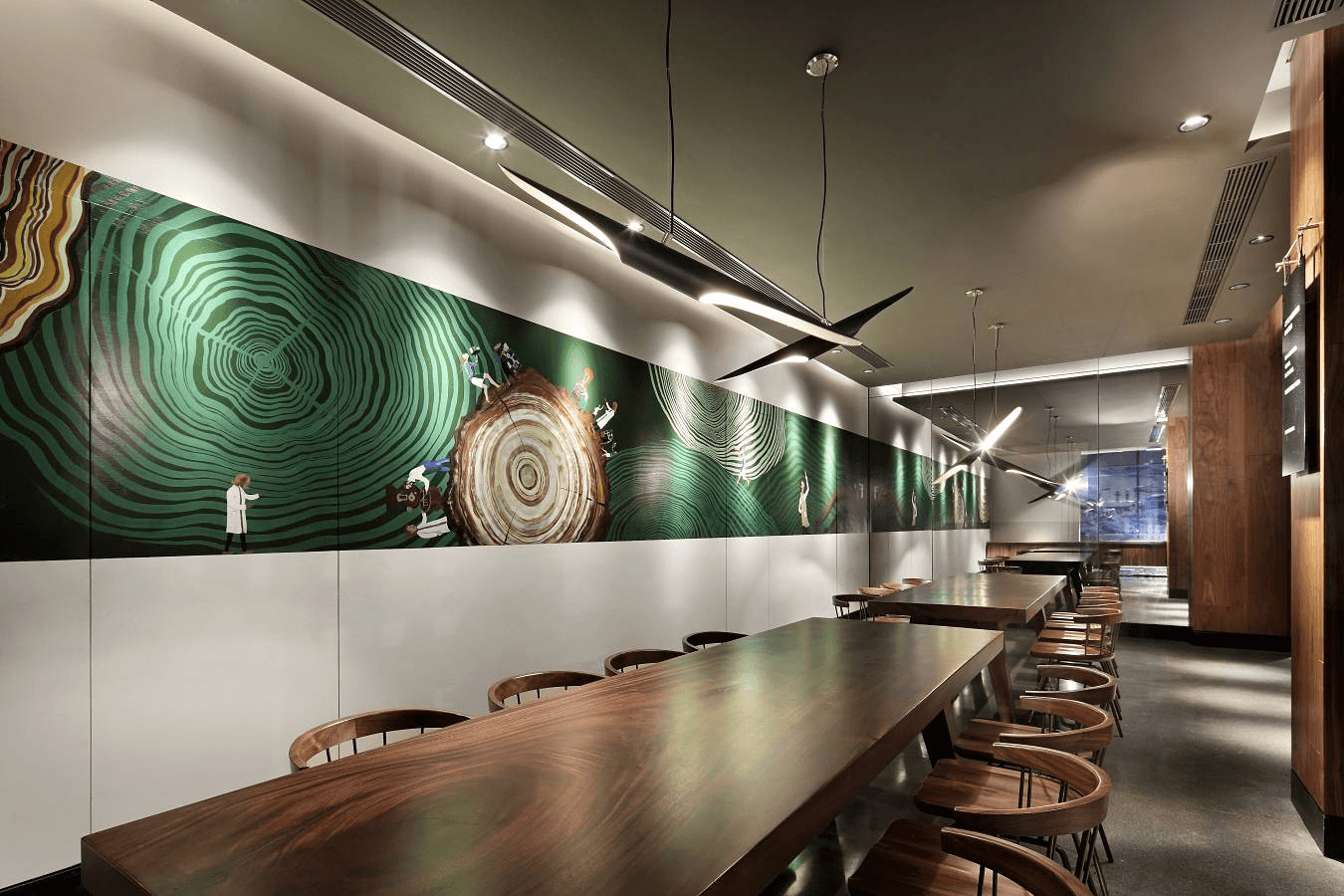Chagee goes public, MIXUE doubles, is China's new tea drink expected to surpass Starbucks?

RockFlow Shayne
April 18, 2025 · 14 min read

Highlight:
1)With strong performance (GMV 29.50 billion yuan, net profit margin of 20.27%, 6440 stores), Chagee went public in the United States, trying to become a pioneer in the internationalization of Chinese tea beverage brands through the "cultural going global" strategy and localized production.
2)MIXUE successfully occupied the Non-Major market with the model of "supply chain is hegemony" (97% of revenue comes from the supply chain, and 12-hour cold chain covers 90% of the country), proving that the low-price strategy is backed by extreme supply chain management capabilities.
3)Starbucks China is trapped in the dilemma of "defending the third space" (market share drops by 8%), facing the dual challenges of losing pricing power and cultural generation gap, reflecting that Chinese tea beverage brands are restructuring the industry and have the voice over.
The IPO of Chagee is imminent, with the stock code "CHA". As a leader in new tea drinks, it has shown remarkable growth data: GMV increased by 173% YoY to 29.50 billion yuan in 2024, Net Profit rate of 20.27% led the industry, and the number of stores increased nearly 6 times to 6440 within two years.
Behind this impressive data, there are three important insights from Chagee:
The perfect balance between scale and standardization Chagee successfully solved the biggest pain point in the tea industry: how to maintain quality during rapid expansion. The ultra-low store closure rate of 1.5% proves the success of its standardized operation system, breaking the industry curse of "scale and quality cannot be achieved at the same time".
Urban strategic transformation of new tea drinks While competitors are still focusing on the Non-Major market, Chagee has already established more than 3,000 stores in first- and second-tier cities. This "reverse penetration" strategy not only enhances the brand tone, but also lays the foundation for future internationalization.
Globalization touchstone for Chinese consumer brands Against the backdrop of tense Sino-US relations and stricter regulation, the choice of Chagee to go public in the US is of symbolic significance. Its concept of "cultural going global" and localized production strategy may provide a new paradigm for the internationalization of Chinese consumer brands.
The IPO of Chagee is not only a financing activity, but also an important milestone for Chinese consumer brands to go global. Its success or failure will affect the internationalization process of the entire Chinese tea beverage industry and provide important reference for the overseas expansion of other Chinese consumer brands.
In this article, the RockFlow investment research team will provide you with an in-depth analysis of the grand cultural capital export experiment of Chagee. And compare MIXUE and Starbucks China, two important players in the freshly made beverage market, to take you through the quietly changing situation of China's tea beverage consumption market.
Overlord Exiting Yunnan: Capital Narrative Experiment of Cultural Capital Globalization
From the tea aroma of Kunming Old Street to the Trading Desk on Wall Street, Chagee completed a commercial civilization leap in 7 years.
This tea brand, which started in Yunnan, is emerging in the global market at an astonishing speed. While MIXUE is building fortresses with 5 yuan lemonade in rural markets, Chagee is trying to compile Chinese tea culture into a universal code for global Capital Markets.
Founded by Zhang Junjie in 2017, Chagee opened its first store in Yunnan Province and has since rapidly expanded in China and even overseas. The tea brand had sales of 29.50 billion yuan (4.03 billion USD) last year. Behind the lightning layout of 6,440 stores in 2024 is its ambition to compile "Chinese tea culture" into the language of global capital.

It plans to serve customers in 100 countries, selling 15 billion cups a year and aggressively expanding its global presence. In recent years, it has expanded into South East Asia, entering MY, Singapore and Thailand.
Unlike MIXUE's supply chain monster model, Chagee is considered the "Starbucks of the tea industry", embodying the essence of Starbucks from Visual Identity to store layout, product strategy, and brand story. Essentially, they are Starbucks' Eastern counterparts.
Currently, the GMV of Chagee has surpassed Starbucks China (3 billion USD), while the profit margin is equivalent to Starbucks' 16%. Such impressive performance is likely to enhance its confidence in going public in the United States.
However, the expansion of Chagee is not without challenges. With more than 3,000 stores in first- and second-tier cities, how to maintain a low store closure rate (currently 1.5%) without affecting sales has become its main problem.
The IPO of Chagee is not only an action of Capital Markets, but also an attempt to export culture. By listing on NASDAQ, Chagee hopes to promote Chinese tea culture globally. However, in the face of fierce competition from competitors such as MIXUE, it remains to be seen whether Chagee can continue to maintain its leading position in the international market.
In addition, the stock code "CHA" of Chagee indicates that their ambition is not limited to selling milk tea, but also extends to promoting Chinese tea culture globally. Pearl milk tea itself may not be special, but Chinese tea cultural heritage is an intangible and scarce asset that gives brand power.
If Chinese tea culture is successfully spread to all parts of the world through the pearl milk tea brand, will Chinese tea brands also enjoy a high reputation globally? After all, China produces half of the world's tea, but there is still no truly influential Chinese tea brand.
MIXUE: The Non-Major Market Dialectics of Supply Chain Empires
MIXUE, a tea brand that started in Zhengzhou, Henan, is known for its strong supply chain management capabilities and extreme cost control. Since its establishment in 1997, MIXUE has become one of the largest catering chain enterprises in the world, with more than 45,000 stores.
In the fireworks of the urban village in Zhengzhou, brothers Zhang Hongchao and Zhang Hongfu proved the truth of "supply chain is hegemony" in 27 years. When the outside world was amazed by the grassroots counterattack of 1 yuan ice cream, what really deserves to be included in business school textbooks are two core data.
97% of revenue comes from the supply chain 12-Hour cold chain direct access to stores, covering 90% of China's territory
The Zhang brothers realized the importance of the supply chain in the catering industry early on. Since 2007, MIXUE has been establishing raw material factories in the suburbs of Zhengzhou, although initially these factories only processed ice cream powder and waffle cones. In 2012, they expanded their scale and built a larger core raw material production factory - not only producing ice cream, but also producing beverage products. Later, they even began to grow their own fruits, striving to have full control from agricultural planting to internal processing.

In addition, since 2014, MIXUE has continuously invested in logistics operations to ensure that franchisees receive materials with the lowest cost and shortest delay. As of 2023, MIXUE has established 26 main warehouses nationwide, serving stores covering 31 provinces across the country, and has achieved over 90% of domestic store cold chain logistics coverage.
MIXUE is trying to replicate its success in the global market and has established localization warehousing systems in four countries in South East Asia, including seven self-operated warehouses, to support its globalization strategy.
Interestingly, with such a strong supply chain, MIXUE does not have high requirements for franchisees. It mainly earns revenue by providing raw materials and equipment (accounting for 97%) to franchisees, rather than charging high franchise fees or sharing.
This "heavy back-end, light front-end" model allows MIXUE to maximize the advantages of vertical integration of the back-end, while rapidly expanding its product line at low prices and establishing a sustained win-win relationship with franchisees.
Due to the fact that MIXUE's products are generally much cheaper than their peers, with most products priced at only 5 to 8 yuan, almost half of their competitors' congeneric products, many people believe that their success is due to their low-price strategy. In fact, this is only superficial. Their real secret lies in extreme supply chain management, which ensures profitability and enables large-scale replication at ultra-low prices.
This empire, which rose from rural areas in Henan, essentially used the "countryside surrounding the city" of the township market to complete the supply chain counterattack against Western fast-moving consumer goods giants. Although many people regard MIXUE as a company similar to Pinduoduo due to its low-price image, in fact, it is more like Coca-Cola or McDonald's. It maintains a cost-leading position through a strong Competitive Edge (self-controlled supply chain and scale advantage), which competitors cannot replicate.
Based on the GMV in 2023, MIXUE is the largest freshly made beverage company in China and the fourth largest in the world. The company's market share in China is about 11.3% and its global market share is about 2.2%.
From 2021 to 2023, the compound annual growth rate of MIXUE's revenue reached 40.05%. As of the end of the third quarter of 2024, the revenue increased by 21.1% YoY, reaching 18.70 billion yuan. This growth data is better than competitors such as Chabaidao and Guming. However, compared with 2021-2023, the revenue growth in 2024 has slowed down.
In addition, MIXUE's low-price strategy may also face challenges. In terms of Product Research & Development, MIXUE's investment is much lower than that of its competitors, which may lead to its lack of product innovation. In addition, although it has achieved certain success in the South East Asia market, further exploration is needed on how to replicate this model in a wider international market. Especially in supply chain management and product localization, MIXUE needs more investment and innovation.
Starbucks China: The Darkest Moment of the Third Space Defense War

Everything stems from lost pricing power and shattered elite narratives.
Starbucks China is facing unprecedented challenges. With the rise of local brands, Starbucks' market share has been declining year by year. By 2024, its market share has declined by 8%, facing fierce market competition and loss of pricing power.
Starbucks' dilemma is that its traditional brand positioning and pricing strategy can no longer meet the needs of the new generation of consumers. With the rise of Generation Z consumers, Starbucks needs to re-examine its brand perception and product strategy to cope with the constantly changing market environment.
In addition, Starbucks also faces challenges in supply chain management and product localization. With the continuous innovation of local brands in these areas, Starbucks needs to accelerate its pace to maintain its market competitiveness.
Starbucks is actively promoting digital transformation to meet market challenges. However, the implementation of the digital strategy is not smooth. Although the proportion of Mini Program orders has increased, the Operational Efficiency of stores is decreasing.
Starbucks' management team in China also faces challenges. Although the new CEO has rich experience in digitalization and consulting, he lacks experience in operating brick and mortar stores, which may limit its strategic implementation in the Chinese market.
Starbucks needs to find a balance between digital transformation and brick and mortar store operations to respond to the rapidly changing market and diverse needs of consumers.
Under the anxious gaze of the Seattle headquarters, Starbucks is experiencing the most dangerous moment in its 25-year history in China. The current digital reform is not so much a strategic upgrade as it is a difficult compromise on the belief in the "third space" - when Tyrant Tea Lady used the "CHA" promotional video to build a cultural utopia, Starbucks was forced to distribute discount coupons between Meituan LIVE.
Starbucks is currently facing two structural dilemmas:
Pricing anchor break: Although Luckin Coffee's price war has eased, the 12-20 yuan price band has been completely divided by local brands Generation Z prefers to pay a premium for "Chinese tea culture" rather than American elite narrative
If CHA code can really conquer Wall Street with Chinese tea culture, are the traditional tea merchants lurking in the Longjing Village of West Lake and the tea fields of Wuyi Mountain witnessing the historic migration of the category has the voice over? The answer may be hidden in Zhang Junjie's wildness - when 15 billion cups of "Modern Oriental Tea" flow down the global throat every year, who still remembers which continent Starbucks' coffee beans come from?
The final battle: the reconstruction of the world system of freshly made beverages
In the global freshly made beverage market, Chagee, MIXUE, and Starbucks represent three different forms of commercial civilization. Chagee has achieved global expansion of the brand through cultural capital and extreme efficiency; MIXUE has occupied a dominant market position through strong supply chain management and low-price strategies; while Starbucks is trying to defend its market position in the third space through digital transformation and brand reshaping.
The collision and integration of these three business models will profoundly affect the future pattern of the global freshly made beverage market. With the continuous changes in consumer demand and the intensification of market competition, finding a balance between cultural empowerment, supply chain management, and brand positioning will become the key to corporate success.
Looking to the future, the global freshly made beverage market will present the following possibilities:
Scenario 1: Through its strong cultural output and brand influence, Chagee has further expanded in the international market and become the leader in the global tea beverage market. Scenario 2: MIXUE replicates its successful model in more international markets through its strong supply chain management and cost control capabilities, further consolidating its market position. Scenario 3: Starbucks regained its leadership position in China through digital transformation and rebranding.
Conclusion
When Chagee IPO on NASDAQ, Zhang Junjie may think of the clouds and mist drifting over Yunnan Tea Mountain - which is not only the starting point of business wisdom, but also the origin of civilization output. This war that began with milk tea will eventually evolve into the ultimate competition of different forms of commercial civilization.
The MIXUE logistics vehicle shuttling through the Zhengzhou warehouse and the anxious Starbucks executives at the Seattle headquarters are witnessing the power shift in the world of tea beverage consumer goods.


